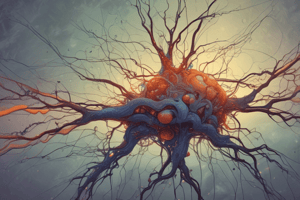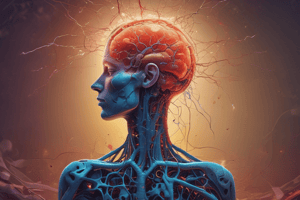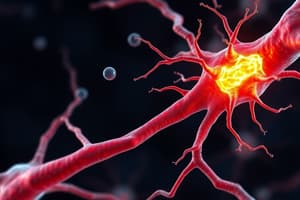Podcast
Questions and Answers
What triggers the release of neurotransmitters from synaptic vesicles?
What triggers the release of neurotransmitters from synaptic vesicles?
- The breakdown of SNARE proteins
- The binding of neurotransmitter to receptors
- An increase in intracellular Ca2+ concentration (correct)
- The closing of voltage-gated Na+ channels
What role does synaptotagmin play in neurotransmitter release?
What role does synaptotagmin play in neurotransmitter release?
- It breaks down neurotransmitters in the synaptic cleft
- It promotes the binding of neurotransmitters to receptors
- It generates action potentials in the postsynaptic cell
- It reacts with SNARE proteins to facilitate membrane fusion (correct)
What happens to neurotransmitters after they diffuse across the synaptic cleft?
What happens to neurotransmitters after they diffuse across the synaptic cleft?
- They bind to specific receptors on the postsynaptic membrane (correct)
- They are immediately destroyed by enzymes
- They are reabsorbed by the presynaptic neuron without binding
- They create action potentials in the presynaptic neuron
What effect does the binding of neurotransmitter to ion channels have in the postsynaptic cell?
What effect does the binding of neurotransmitter to ion channels have in the postsynaptic cell?
How is the frequency of impulses related to the quantity of neurotransmitter released?
How is the frequency of impulses related to the quantity of neurotransmitter released?
What is the primary role of the presynaptic neuron in a synaptic connection?
What is the primary role of the presynaptic neuron in a synaptic connection?
Which of the following describes a chemical synapse?
Which of the following describes a chemical synapse?
What separates the presynaptic neuron from the postsynaptic neuron in a chemical synapse?
What separates the presynaptic neuron from the postsynaptic neuron in a chemical synapse?
What determines the unidirectional communication characteristic of chemical synapses?
What determines the unidirectional communication characteristic of chemical synapses?
Which type of synaptic connection is most common between an axon terminal and a dendrite?
Which type of synaptic connection is most common between an axon terminal and a dendrite?
What is meant by the term synaptic integration?
What is meant by the term synaptic integration?
Which type of neurotransmitter receptor is characterized by slower, longer-lasting effects?
Which type of neurotransmitter receptor is characterized by slower, longer-lasting effects?
In terms of summation, what does spatial summation involve?
In terms of summation, what does spatial summation involve?
Which step is NOT involved in the transmission across chemical synapses?
Which step is NOT involved in the transmission across chemical synapses?
What is the primary function of neurotransmitters in synaptic transmission?
What is the primary function of neurotransmitters in synaptic transmission?
What is one of the primary methods by which neurotransmitter effects are terminated?
What is one of the primary methods by which neurotransmitter effects are terminated?
What is the typical range of time for synaptic delay in chemical synapses?
What is the typical range of time for synaptic delay in chemical synapses?
Which characteristic best describes electrical synapses?
Which characteristic best describes electrical synapses?
Which of the following processes is NOT a mechanism for terminating neurotransmitter effects?
Which of the following processes is NOT a mechanism for terminating neurotransmitter effects?
In which type of synapse does communication generally occur more rapidly?
In which type of synapse does communication generally occur more rapidly?
Which of the following neurotransmitters is usually excitatory?
Which of the following neurotransmitters is usually excitatory?
What characterizes the direct action of neurotransmitters?
What characterizes the direct action of neurotransmitters?
What type of receptors are involved in immediate and brief actions?
What type of receptors are involved in immediate and brief actions?
Which type of neurotransmitter action usually has broader and longer-lasting effects?
Which type of neurotransmitter action usually has broader and longer-lasting effects?
What is a characteristic of neural integration?
What is a characteristic of neural integration?
What type of processing involves a single pathway to a specific destination?
What type of processing involves a single pathway to a specific destination?
What is one example of a spinal reflex?
What is one example of a spinal reflex?
What type of processing allows one stimulus to generate multiple responses?
What type of processing allows one stimulus to generate multiple responses?
What determines the strength of postsynaptic potentials?
What determines the strength of postsynaptic potentials?
Which of the following correctly describes an excitatory postsynaptic potential (EPSP)?
Which of the following correctly describes an excitatory postsynaptic potential (EPSP)?
What is the primary effect of presynaptic inhibition?
What is the primary effect of presynaptic inhibition?
What do temporal and spatial summation have in common?
What do temporal and spatial summation have in common?
How does synaptic potentiation affect neurotransmitter release?
How does synaptic potentiation affect neurotransmitter release?
What role do chemically gated channels play in EPSPs?
What role do chemically gated channels play in EPSPs?
Which type of summation occurs when multiple presynaptic neurons stimulate a postsynaptic neuron at the same time?
Which type of summation occurs when multiple presynaptic neurons stimulate a postsynaptic neuron at the same time?
What is the effect of inhibitory postsynaptic potentials (IPSPs) on the postsynaptic neuron?
What is the effect of inhibitory postsynaptic potentials (IPSPs) on the postsynaptic neuron?
Which characteristic is NOT a feature of neurotransmitters?
Which characteristic is NOT a feature of neurotransmitters?
Which phenomenon describes the increase in neurotransmitter release due to higher calcium ion concentrations in the presynaptic neuron?
Which phenomenon describes the increase in neurotransmitter release due to higher calcium ion concentrations in the presynaptic neuron?
Flashcards
Synaptic Delay
Synaptic Delay
The time it takes for a neurotransmitter to be released, travel across the synaptic cleft, and bind to receptors on the post-synaptic neuron.
Synapse
Synapse
A specialized junction where communication occurs between neurons or between a neuron and another type of cell.
Electrical Synapse
Electrical Synapse
A synapse where neurons are directly connected by gap junctions, allowing for rapid communication.
Chemical Synapse
Chemical Synapse
Signup and view all the flashcards
Neurotransmitter Termination
Neurotransmitter Termination
Signup and view all the flashcards
Calcium's role in neurotransmitter release
Calcium's role in neurotransmitter release
Signup and view all the flashcards
Neurotransmitter diffusion across the synapse
Neurotransmitter diffusion across the synapse
Signup and view all the flashcards
Neurotransmitter binding and graded potentials
Neurotransmitter binding and graded potentials
Signup and view all the flashcards
Impulse frequency and neurotransmitter release
Impulse frequency and neurotransmitter release
Signup and view all the flashcards
The role of SNARE proteins
The role of SNARE proteins
Signup and view all the flashcards
What is a synapse?
What is a synapse?
Signup and view all the flashcards
Describe a typical electrical synapse
Describe a typical electrical synapse
Signup and view all the flashcards
Describe how a chemical synapse works
Describe how a chemical synapse works
Signup and view all the flashcards
What are postsynaptic potentials?
What are postsynaptic potentials?
Signup and view all the flashcards
What is synaptic integration?
What is synaptic integration?
Signup and view all the flashcards
Define summation
Define summation
Signup and view all the flashcards
Differentiate spatial and temporal summation
Differentiate spatial and temporal summation
Signup and view all the flashcards
What are neurotransmitters?
What are neurotransmitters?
Signup and view all the flashcards
What are the 2 types of neurotransmitter receptors?
What are the 2 types of neurotransmitter receptors?
Signup and view all the flashcards
Explain neural integration
Explain neural integration
Signup and view all the flashcards
EPSP (Excitatory Postsynaptic Potential)
EPSP (Excitatory Postsynaptic Potential)
Signup and view all the flashcards
IPSP (Inhibitory Postsynaptic Potential)
IPSP (Inhibitory Postsynaptic Potential)
Signup and view all the flashcards
Summation
Summation
Signup and view all the flashcards
Temporal Summation
Temporal Summation
Signup and view all the flashcards
Spatial Summation
Spatial Summation
Signup and view all the flashcards
Synaptic Potentiation
Synaptic Potentiation
Signup and view all the flashcards
Long-Term Potentiation (LTP)
Long-Term Potentiation (LTP)
Signup and view all the flashcards
Presynaptic Inhibition
Presynaptic Inhibition
Signup and view all the flashcards
Neurotransmitter
Neurotransmitter
Signup and view all the flashcards
Neurotransmitter Effects
Neurotransmitter Effects
Signup and view all the flashcards
Inhibitory neurotransmitter
Inhibitory neurotransmitter
Signup and view all the flashcards
Excitatory neurotransmitter
Excitatory neurotransmitter
Signup and view all the flashcards
Direct action neurotransmitter
Direct action neurotransmitter
Signup and view all the flashcards
Indirect action neurotransmitter
Indirect action neurotransmitter
Signup and view all the flashcards
Channel-linked receptor
Channel-linked receptor
Signup and view all the flashcards
G protein-linked receptor
G protein-linked receptor
Signup and view all the flashcards
Neural integration
Neural integration
Signup and view all the flashcards
Serial processing
Serial processing
Signup and view all the flashcards
Study Notes
Nervous system introduction
- The nervous system allows information to flow from neuron to neuron
- Neurons are connected by synapses
Synapses
- Synapses are junctions for information transfer
- They connect one neuron to another neuron, or to an effector cell.
- Synapses can be chemical or electrical
Types of Synapses
-
Chemical Synapses:
- Most common type of synapse.
- Specialized for releasing and receiving chemical neurotransmitters.
- Two parts:
- Axon terminal of the presynaptic neuron: Contains synaptic vesicles filled with neurotransmitter.
- Receptor region on the postsynaptic neuron's membrane: Receives neurotransmitters.
- Separated by a fluid-filled synaptic cleft.
- Transmission mechanism:
- Action potential arrives at the axon terminal
- Voltage-gated Ca2+ channels open, and Ca2+ enters the axon terminal
- Ca2+ entry causes synaptic vesicles to release neurotransmitters by exocytosis
- Neurotransmitters diffuse across the synaptic cleft, and bind to specific receptors on the postsynaptic membrane
- Binding of neurotransmitters open ion channels, resulting in graded potentials
- Neurotransmitter effects are terminated by reuptake, enzymatic degradation, or diffusion
-
Electrical Synapses:
- Less common than chemical synapses
- Neurons are electrically coupled by gap junctions.
- Communication is very rapid, unidirectional or bidirectional.
- Found in regions responsible for eye movements, hippocampus, and areas involved in emotions and memory
- Often abundant in embryonic tissue
Synaptic connections
- Axodendritic: Between axon terminals of one neuron and dendrites of others
- Axosomatic: Between axon terminals of one neuron and soma (cell body) of others
- Axoaxonal: Between axon terminals of one neuron to another.
- Dendrodendritic: Between dendrite to dendrite
- Somatodendritic: Between dendrite to soma
Postsynaptic potentials
- Neurotransmitter receptors cause graded potentials.
- Strength varies by:
- Amount of neurotransmitter released
- Time neurotransmitter stays in cleft
- Two types based on effect of chemical synapse:
- EPSP (Excitatory postsynaptic potential)
- IPSP (Inhibitory postsynaptic potential)
Excitatory Synapses and EPSPs
- Neurotransmitter binding opens chemically gated channels.
- Allows flow of Na+ and K+ in opposite directions simultaneously.
- Na+ influx is greater than K+ efflux resulting in graded potential depolarisation called Excitatory postsynaptic potential (EPSP).
- Triggers action potential if threshold is reached
Inhibitory Synapses and IPSPs
- Neurotransmitter binding opens channels (e.g., K+ or Cl- channels).
- If K+ channels open, K+ moves out of the cell.
- If Cl- channels open, Cl- moves into the cell.
- Reduces the ability to produce an action potential.
Summation of Synaptic Events
- Single EPSP cannot trigger an action potential, but EPSPs can summate to influence the postsynaptic neuron.
- IPSPs can summate similarly.
- Two types of summation:
- Temporal summation: Rapid firing of presynaptic neurons causing EPSPs close in time.
- Spatial summation: Simultaneous firing of multiple presynaptic neurons causes EPSPs that occur simultaneously at various locations on the postsynaptic neuron
Synaptic Potential
- Repeated use increases the ability of a presynaptic cell to excite postsynaptic neuron
- Ca2+ concentration increases in presynaptic terminal, causing release of more neurotransmitter
- Leads to more EPSPs
Neurotransmitters
- Most neurons make multiple neurotransmitters.
- Released at different stimulation frequencies
- Produce different effects depending on receptors.
- Classified by:
-Chemical structure
- Function
Neurotransmitter Receptors
-
Channel-linked receptors (ionotropic):
- Ligand-gated ion channels.
- Action is immediate and brief.
- Excitatory receptors, e.g., for Na+, contribute to depolarization.
- Inhibitory receptors, e.g., for Cl-, cause hyperpolarization.
-
G protein-linked receptors (metabotropic):
- Responses are indirect, complex, slow, often prolonged.
- Involve transmembrane protein complexes.
- Use second messenger systems.
- Cause widespread metabolic changes.
- Example: Muscarinic ACh receptors
Neural Integration
- Neurons function as groups to contribute to broader neural functions.
- There are billions of neurons in the CNS requiring smooth operation
Patterns of Neural Processing
- Serial processing:
- Input travels along one pathway to a specific destination.
- All-or-none manner to produce specific response (Reflex)
- Parallel processing:
- Input travels along several pathways.
- Different parts of circuitry deal with information simultaneously.
- Important for higher-level mental functioning. (eg. Sensing smell)
Review Questions
- What are the different types of postsynaptic potentials?
- How does summation occur?
- How is long-term memory formed?
- What are 2 types of neurotransmitter receptors?
- What is the difference between serial and parallel processing?
Studying That Suits You
Use AI to generate personalized quizzes and flashcards to suit your learning preferences.




